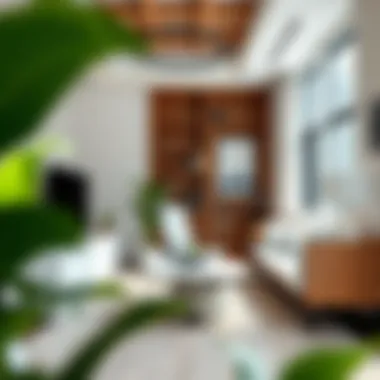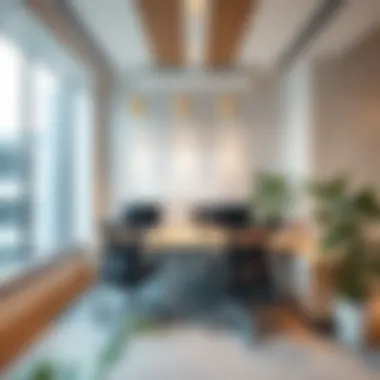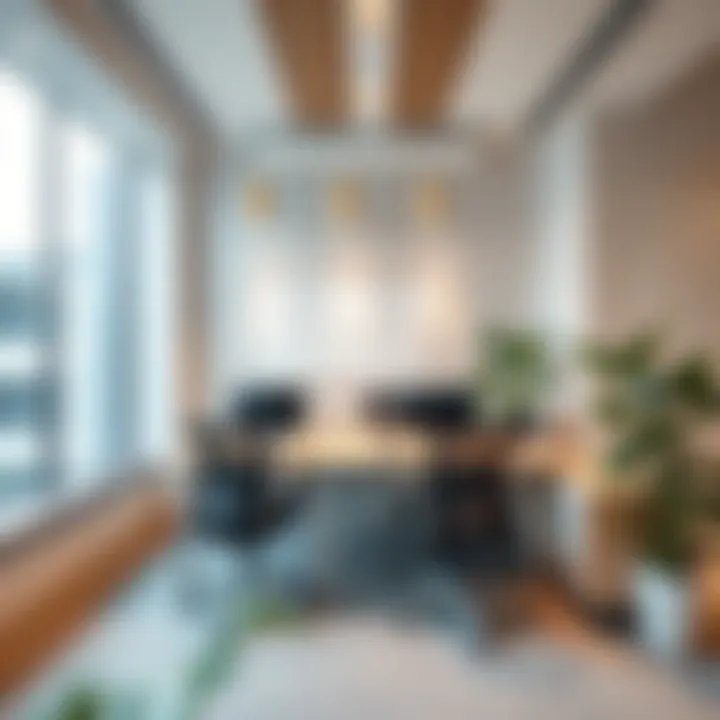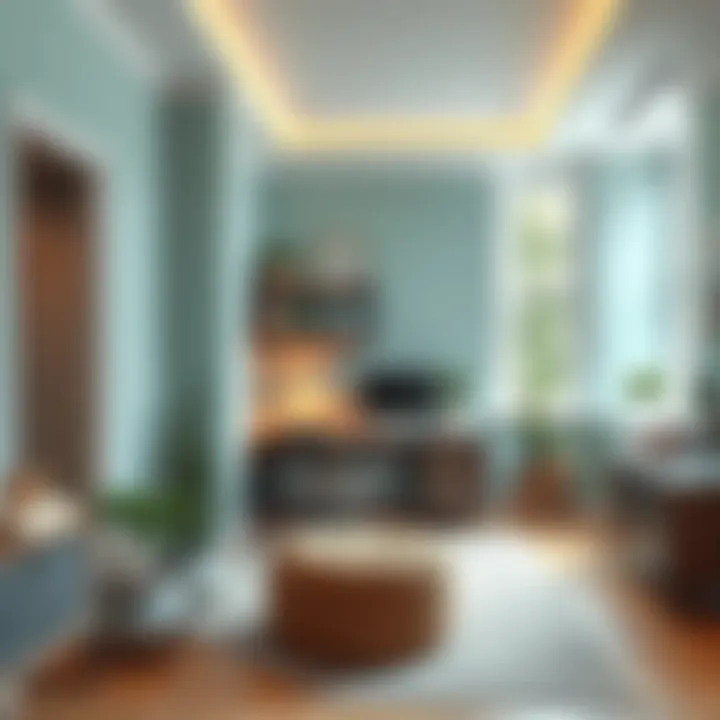Small Office Design Layout: Optimize Space and Functionality


Intro
In today’s fast-paced world, small office spaces are becoming increasingly common. Whether you are a remote worker or run a small business from home, knowing how to effectively maximize every square foot of your workspace can be a game-changer. This article explores practical strategies to design small offices that don’t just function well but also motivate productivity and inspire creativity.
A thoughtfully organized small office can not only elevate your work experience but also enhance the aesthetics of a room. By considering functionality, organization, and light, you can craft an environment that feels spacious and welcoming. Let’s dive into how design inspiration plays a crucial role in achieving just that.
Design Inspiration
Finding the right design inspiration for your small office can be as important as the physical layout itself. It sets the tone and enhances the ambiance necessary for focused work. Below, we’ll explore trending styles, popular color palettes, and other elements to consider.
Trending Styles and Themes
Small office design trends often reflect a blend of comfort and style. Some of the trending styles that resonate well with such spaces include:
- Minimalist: Focus on clean lines and clutter-free surfaces. This style emphasizes functionality and can make a small area feel more open.
- Scandinavian: A perfect mix of coziness and elegance, this style often uses natural materials and light colors that make spaces feel large and airy.
- Industrial: Exposed ceilings and raw materials like brick, wood, and metal add character and can be quite striking in a small office.
- Eco-Friendly: Sustainable materials and plants are incorporated, creating not just a workspace but also a tranquil environment.
Each of these styles can be customized to fit your personal taste and the specific needs of your work function.
Color Palettes and Combinations
The colors you choose can greatly impact your mood and productivity. Light colors like whites and pastels can make a small office feel larger, while bold shades can energize a workspace. Here is a few combinations worth considering:
- Soft Whites with Pops of Green: This can create a refreshing atmosphere, especially when combined with indoor plants.
- Cool Blues and Grays: Known for their calming effects, they are excellent for focus.
- Earthy Tones: Shades of brown, beige, and mustard yellows can bring warmth to a small office, fostering a creative environment.
Think about how you can make each color choice contribute to the overall atmosphere you wish to create.
"Good design is about making a smaller space work harder while looking good at the same time."
Implementing these elements thoughtfully can yield a workspace that not only meets your functional needs but also makes a positive aesthetic statement.
Understanding Small Office Design
Designing a small office may seem like a straightforward effort, but the intricacies involved in making the most of a limited space can’t be overstated. Small office design is not just about squeezing furniture into a room; it’s about creating an environment that maximizes productivity, enhances comfort, and reflects professionalism. The layout of a small office significantly impacts how well the space serves its function, which is critical for everything from day-to-day operations to client perceptions.
Defining a Small Office
A small office usually refers to workspaces that occupy less than 500 square feet. These can range from home offices tucked away in a corner to shared workspaces in co-working environments. It’s pivotal to note that size isn’t just a number — it often determines the types of office layouts, designs, and organizational strategies that might be employed. The challenge lies in how to make a small office not feel cramped but rather open and inviting.
Consider the difference between a small office that feels desperate and stressed versus one that invites collaboration and creativity. That perspective hinges on thoughtful design that recognizes the limitations of space while still maximizing its potential.
Importance of Effective Layout
Why does layout matter? Simply put, it shapes the workflow. An efficient layout can lead to enhanced productivity and employee satisfaction.
- Increased Productivity: A carefully planned layout helps employees navigate their tasks more effectively. Think of reducing time spent moving between desks, storage, and collaborative spaces. Every step counts when the office space is tight.
- Enhanced Communication: Effective layouts encourage open communication by positioning teams close to each other or in a way that facilitates spontaneous discussions. This is particularly essential in small businesses where teamwork fuels innovation.
- Optimized Space Utilization: A smart layout utilizes every nook and cranny. For instance, integrating built-in shelving can free floor space for movement while keeping essential materials within reach.
- Employee Comfort: Comfort is not a luxury; it’s a necessity. A layout that allows for natural light, comfortable seating, and quiet zones can improve well-being and, in turn, retention rates.
As a rule of thumb, the design should marry functionality with aesthetics, taking into account the specific needs of the workforce. A well-designed office can be the difference between just working and truly thriving.
"Spaces must work hand in hand with people, enhancing their capabilities rather than stifling them."
Thus, understanding the nuances of small office design is foundational to creating a workspace that isn’t just a place to work, but a nurturing environment that motivates and inspires.
Key Principles of Office Layout
Creating an efficient office layout is a crucial element for small office design that directly impacts the overall work environment. The principles of office layout serve as a guiding framework, allowing designers and business owners to optimize space utilization and enhance productivity. Key principles such as functionality, comfort, and organization emerge as essential elements for maximizing the utility of a small office. Understanding and implementing these principles can shape not just how space looks, but how it functions for its users.
Functionality Over Aesthetics
When it comes to small office design, prioritizing functionality is paramount. It's easy to get caught up in the allure of striking aesthetics that may look great in magazines but don't necessarily suit a real-world office setup. Selecting designs that promote efficient workflows and effective communication among team members is key. For instance, consider arranging desks to facilitate interaction while still providing the necessary space for individual tasks.
Moreover, utilizing furniture that serves dual purposes can also significantly enhance functionality. Desks with built-in storage or meeting tables that can fold away when not in use are perfect examples. This approach keeps clutter at bay and allows for flexibility, which is crucial in smaller spaces. Opting for a layout that facilitates ease of movement can also foster a more dynamic work environment, preventing the dreaded feeling of confinement that sometimes comes with smaller offices.
- Incorporate movable partitions: This helps to define spaces without enclosing them, allowing for changes in layout as needs shift.
- Consider tech integration: Ensure there’s adequate power access and networking capabilities throughout the office.
- Plan for pathways: Keep passageways clear to ensure all employees can move freely without disruption.
Balancing Comfort and Productivity
A workspace should be more than just a collection of desks and chairs; it should be a place where productivity flourishes. Striking a balance between comfort and productivity becomes vital in small office design. Too often, businesses compromise comfort for aesthetics or cost, which can backfire in terms of employee satisfaction and output.
The selection of ergonomic furniture, such as adjustable chairs and desks, can significantly improve the comfort levels of employees. Research shows that comfort leads to happier employees who are more focused on their tasks. Additionally, incorporating elements of nature, such as plants, can create a more inviting atmosphere that boosts mood and productivity.
Aside from furniture choices, the overall office environment plays a pivotal role. Temperature control, adequate space, and noise management can contribute substantially to employee comfort. For instance, sound-absorbing materials can mitigate distracting noises, creating a conducive space for concentration. Examples of implementing this might include using sound-dampening panels or quiet zones for tasks requiring deep focus.
In summary, an understanding of key principles foundational to small office layout will not only optimize the workspace but also enhance employee experience. It's about striking the right chord between aesthetic appeal and high functionality while ensuring that employees find comfort and motivation in their surroundings.
"A thoughtful office layout not only creates greater efficiency but invites creativity and collaboration, making it a key investment for any small business."
By integrating these principles effectively, business owners can craft environments that reflect their values while catering to the needs of their team. The workplace, after all, should serve its people, turning daily grind into productive strides.
Layout Options for Small Offices
When it comes to designing small offices, the layout is everything. The right layout can dramatically influence how the space is utilized, catering to everyday workflows and defining the overall ambiance of the workplace. This section dives into various layout options, highlighting their benefits and considerations that can help guide your design choices for a small office environment.
Open Plan Layouts
Open plan layouts are all the rage these days, and for good reason. They promote collaboration and communication among team members, breaking down the barriers that traditional cubicles can create. By removing physical walls, this layout fosters a sense of unity, allowing ideas and creativity to flow freely.
- Benefits: This style doesn't just enhance communication; it also makes the best use of available square footage, providing a spacious feel even in tighter environments. Adding shared desks or communal tables can create a welcoming atmosphere.
- Considerations: While open spaces are great, they can sometimes lead to distractions. It's essential to think about sound management and privacy solutions, such as using strategic panel placements or noise-cancelling features.
Cubicle Configuration
Cubicle configurations offer a more traditional approach to office design. While they may seem a tad dated for some, they provide a high degree of individual space and privacy. In a small office, cubicles can efficiently delineate areas for different functions while still being mindful of the limited square footage.


- Benefits: The main advantage of cubicle layout is that it provides each employee with their own dedicated space. This can lead to increased productivity as individuals feel less distracted by constant social interactions.
- Considerations: Careful planning is crucial in a small office; too many cubicles can make a space feel cramped. Reach out to organizational experts to find efficient configurations that can maximize your usable space without sacrificing comfort.
Hybrid Solutions
In today’s fast-evolving work environments, hybrid solutions combine elements of both open plan and cubicle setups. This offers a unique opportunity to cater to diverse working styles while maintaining a cohesive design aesthetic.
- Benefits: A hybrid layout allows organizations to offer quiet areas for focused work alongside vibrant, interactive spaces for collaboration. It’s like having the best of both worlds! Employees can choose where they feel most comfortable and productive.
- Considerations: The challenge here lies in creating clear boundaries in these flexible layouts. Adequate separation without making the workplace feel disjointed is fundamental. Consider thoughtful color schemes or partitions that look modern yet functional.
Hybrid solutions draw the line between teamwork and solitude, recognizing that productivity can flourish in many forms.
With a range of options from open plans to cubicle configurations, and even innovative hybrid designs, the layout of a small office can be tailored to not only maximize space but also enhance functionality. Choosing the right layout is a pivotal step towards creating an efficient working environment that resonates with your business needs. For additional insights and inspiration, you can explore resources like Wikipedia or Britannica.
Selecting the Right Furniture
Choosing the right furniture is more than just finding pieces that look nice; it’s about sculpting an environment that serves both purpose and functionality in a small office space. Every square inch counts when you're squeezed into a smaller area, making the right furniture decisions critical. Not only can carefully chosen pieces enhance workflow, but they also play a huge role in the overall vibe you want your workspace to have.
Here are a few key elements to consider:
- Space Utility: The furniture should fit the size of your office without cramping it. Oversized desks or chairs can make a room feel even smaller. On the flip side, pieces that are too small can fail to meet your operational needs.
- Budget Consideration: Quality pieces can come with a hefty price tag. However, there are smart investments like multi-functional furniture that can do the heavy lifting without breaking the bank.
- Style Compatibility: The furniture choices should harmonize with the aesthetics of your office. This is important because a visually pleasing workspace can impact morale and drive productivity.
Ultimately, selecting the right furniture combines utility with aesthetics, ensuring your workspace not only serves its purpose but also fosters a positive working atmosphere.
Multi-functional Pieces
Multi-functional furniture goes a long way in small office design. Take a desk that doubles as a storage unit; these types of designs offer the best of both worlds by keeping clutter at bay and providing essential workspace. Consider choosing a folding table that can be tucked away when not in use, or a bookshelf that can also serve as a divider between work areas.
Here are some examples of multi-functional pieces:
- Laptops on desking surfaces: For tech-heavy environments, portable desks can easily adjust height for sitting or standing and offer flexibility as needed.
- Convertible office chairs: Chairs that transform into recliners can provide respite during long hours but save space when upright.
The beauty of multi-functional furniture lies in its ability to adapt to your needs, making it easier to create a dynamic workspace with less clutter.
Ergonomic Considerations
When investing in furniture, the importance of ergonomics cannot be overstated. An ergonomic setup ensures comfort during long working hours, thus enhancing productivity and preventing chronic pain or discomfort. Look for chairs with adjustable heights and lumbar support to promote a healthy posture.
A few tips to create an ergonomic workspace include:
- Desk Height: Ideally, your desk surface should be at elbow height when sitting, allowing for a natural arm position.
- Monitor Position: Position monitors about an arm's length away, at eye-level, to reduce strain on the neck.
Incorporating ergonomic designs in your office is an investment in your health and productivity, and in an often-chaotic world of deadlines, should be a top priority.
Storage Solutions
Storage plays a crucial role in maintaining order in small offices. Not only does it help keep clutter at bay—essential for narrowing focus—but it also aids in maximizing the available space. Opt for vertical solutions like shelves and wall-mounted cabinets that draw the eye upward, making the area feel larger.
Some handy storage options you might consider:
- Under-desk drawers: These can neatly tuck away necessary items while keeping things handy.
- Carts with wheels: These can move to where you need them, providing additional workspace or storage and can easily be tucked away when not needed.
- File cabinets that also serve as decor: Filling them with books or plants can make them less utilitarian and more inspiring.
Implementing smart storage solutions not only enhances organization but also contributes to a calmer and more productive workspace.
Selecting the right furniture is akin to choosing the right tools for a job. Each piece should not only serve its purpose but do so in harmony with both the user and the environment.
For further insights on office furniture considerations, visit Wikipedia for detailed discussions on ergonomic design.
Color and Aesthetics in Office Design
The visual appeal of a small office can significantly affect both the productivity and well-being of its occupants. Selecting the right colors and aesthetic elements is not just an exercise in creativity; it has practical implications for how people feel and function in the workplace. A well-thought-out design can create a harmonious environment that fosters positive feelings, boosts morale, and even enhances collaboration among team members. When navigating the intricate balance between aesthetics and functionality, small office spaces can utilize color and decor to build a dynamic atmosphere, encouraging creativity while keeping distractions at bay.
Psychology of Color in Workspaces
Color does not just please the eye; it speaks to the underlying psychology of human experience. Each hue has a unique ability to evoke feelings and inspire actions, making it a powerful tool in office design. Here are some key colors and their perceived effects in the workspace:
- Blue: Often considered calming, shades of blue can help in focus and creativity. It lowers anxiety and fosters mental clarity, making it a preferred choice for meeting rooms or creative studios.
- Green: Associated with nature, green promotes balance and refreshment. It’s great for fostering a sense of tranquility and can be particularly effective for spaces where relaxations is desirable, like break rooms or private offices.
- Yellow: The color of sunshine, yellow stimulates optimism and energy. However, too much yellow can lead to feelings of frustration. Thus, use it sparingly as an accent color rather than the primary tone.
- Red: A bold choice, red can increase excitement and stimulate the senses. It's effective in collaborative workspaces but should be used in moderation, as it may also evoke stress in higher quantities.
When designing a small office, consider integrating these colors thoughtfully using paint, furniture, or accessories. You may want to create a feature wall in a vibrant shade or add colorful elements through artwork and decor.
Incorporating Art and Decor
Art and decor serve more than just aesthetic purposes in a small office. They can also represent corporate identity and personal taste, fostering a connection between the workspace and its users. Here are some ideas for successfully integrating art and decor:
- Local Artwork: Showcase local artists. This not only supports the community but also can instill a sense of pride in the workplace. Rotating exhibits can keep the space fresh and engaging.
- Personal Touches: Including personal items like photos or objects that reflect employees' personalities and hobbies can make the space feel more welcoming. However, striking a balance is key; too many personal items can lead to clutter.
- Functional Decor: Items like stylish bulletin boards or decorative storage solutions can serve both aesthetic and functional purposes. These decisions can boost visual interest without sacrificing practicality.
- Nature Elements: Integrating plants or nature-themed decor can encourage a feeling of wellness and interconnectedness with the outside world. Not only beautifying the space, but greenery has also been shown to improve air quality and mental clarity.
In summary, color and aesthetics play critical roles in small office design. When effectively used, they can transform a bland environment into a vibrant hub of creativity and productivity. Keeping in mind both the psychological effects of color and the importance of personalized decor, you can create a small office that doesn't just serve as a workspace but as an inviting, inspiring environment.
Lighting as a Design Element
Lighting in small office design is not merely a functional aspect; it plays a crucial role in creating an inviting atmosphere and enhancing productivity. With the right lighting, even the smallest spaces can feel larger and more open, allowing for a conducive work environment. Proper lighting can reduce eye strain, influence mood, and even promote a sense of well-being. Therefore, it's essential to consider lighting as much as furniture selection or color scheme when designing a small office.
Natural Light Considerations
One cannot overstate the importance of natural light in a workspace. It can do wonders for one’s mental and physical well-being. Natural light has the unique ability to uplift the spirit of a room, fostering a sense of connection with the outdoors. When considering natural light, think about the orientation of windows, overhangs, and nearby buildings that might block sunlight.
When possible, position desks near windows to maximize exposure to daylight. It's also wise to avoid heavy drapery that can impede light flow. Instead, opt for blinds or sheer curtains, which can filter light while maintaining privacy. A well-placed mirror can also help bounce light around a room, enhancing the overall brightness without the need for additional artificial lights. Incorporating plants as a natural design element can support this as they thrive on natural light and bring a fresh touch.
"Natural lioght can significantly increase the feel of space and freshness in an office, making daily tasks seem less dreary."
Choosing Artificial Lighting
Though natural light is invaluable, it is often not enough, particularly during darker months or in small offices without many windows. In such cases, choosing the right artificial lighting is essential. A combination of ambient, task, and accent lighting can create a balanced lighting environment.
- Ambient Lighting: This is your general lighting, filling the room with soft illumination. Ceiling-mounted fixtures or LED downlights can provide good overall brightness.
- Task Lighting: For work areas, focused lighting such as desk lamps or under-shelf lights is vital. They help reduce shadows on working surfaces and increase visibility where it matters, improving concentration.
- Accent Lighting: Use this sparingly to highlight specific features, like artwork or plants. This can add depth and interest to your space.


When selecting light fixtures, consider energy-efficient options, such as LED lights, which consume less power and last longer. Dimmable lights can also be a fantastic addition; they allow you to adjust the brightness based on the time of day or nature of the work. Always remember to think about color temperature, too – warmer tones can create a cozy feel, while cooler spectra can lend a more energetic vibe, important for stimulating productivity.
Technology Integration in Small Offices
In the modern workspace, integrating technology stands out as an essential aspect of designing an efficient and functional small office. This integration not only streamlines operations but also enhances employee productivity and overall satisfaction. Leveraging technology effectively can lead to better organization, improved communication, and a more pleasant working environment. In small offices where space is a premium, these enhancements often translate directly into significant productivity gains and smarter use of the available area.
A well-planned technology setup should consider tools that simplify everyday tasks. From the right software choices for project management to optimal hardware configurations, every detail counts. Here are a few major considerations when it comes to integrating technology into your small office design:
- Scalability: Choosing solutions that can adapt as your business grows is vital.
- Mobility: In a world where remote work is increasingly common, ensuring you have mobile solutions can greatly increase flexibility.
- User-Friendly Interfaces: Tech should be intuitive, not a burden. Staff should spend less time learning new systems and more time getting work done.
Overall, these factors lead to a smoother functioning of the office, which ultimately reflects in productivity and morale.
Smart Office Solutions
Smart office technology encompasses a range of devices designed to enhance the functionality of your workspace. From IoT (Internet of Things) devices to sophisticated software applications, the right smart solutions can revolutionize the way the office operates. Imagine a situation where your lights adjust based on the amount of natural sunlight filtering through the windows or your heating and cooling system optimizes based on the number of people present in the office. These examples aren’t just futuristic; they are feasible today.
Consider integrating systems like:
- Smart Thermostats: These can learn your temperature preferences and adjust automatically, saving energy.
- Smart Lighting: Use sensors to automatically adjust the brightness based on the time of day or occupancy.
- Collaboration Tools: Software such as Slack and Trello fosters better team communication, making it easier to keep everyone on the same page.
By innovating with smart technology, offices can create a seamless, efficient atmosphere that maximizes both space and functionality.
Ergonomic Tech Sets
When focusing on technology in small office design, ergonomics should not be overlooked. The right ergonomic equipment not only supports employees physically but also plays a role in increasing efficiency. A workstation that promotes good posture and provides comfort helps reduce fatigue and, in turn, enhances productivity.
Some examples of ergonomic tech include:
- Adjustable Desks: These allow users to alternate between sitting and standing, improving circulation and reducing discomfort throughout the day.
- Ergonomic Chairs: A good chair that supports the back and encourages a natural posture can have a dramatic effect on comfort.
- Keyboard and Mouse Designs: Consider equipment that reduces strain on the hands and wrists.
Adopting ergonomic tech is more than just a comfort measure; it is an investment in your employees' health, which pays dividends in productivity and morale.
"The right technology can empower employees to work smarter, not harder, turning small spaces into functional, pleasant environments."
Creating a Flexible Workspace
Creating a flexible workspace is a critical component in small office design. It allows for versatility in how spaces can be utilized, adapting to different needs and functions without major renovations. A flexible office layout offers benefits such as increased productivity, improved collaboration, and optimal use of space, which is essential for small environments where every square foot matters.
With the rise of remote work and changing professional dynamics, having a flexible office design helps accommodate various working styles. Whether it’s for team meetings, solo tasks, or even brainstorming sessions, a flexible plan allows spaces to be rearranged or modified to fit the occasion.
Some important considerations when creating a flexible workspace include:
- Versatile Furniture: Investing in multi-purpose pieces that can easily be moved or reconfigured. This helps to create dynamic spaces without cluttering the office.
- Zoning Areas: Designate specific zones for different activities, allowing the workspace to adapt based on what employees need.
- Easy Access to Technology: Ensure that tech elements, from power outlets to Wi-Fi boosters, are conveniently accessible no matter the furniture arrangement, enhancing efficiency.
In essence, a flexible workspace not only increases functionality but also fosters an inviting atmosphere that can cater to the diverse needs of its occupants.
Adaptable Furniture Arrangements
When it comes to small offices, adaptable furniture arrangements can make all the difference. A well-thought-out arrangement should consider how space can be transformed quickly and easily, depending on the task at hand or the number of people present.
Consider these elements when planning furniture arrangements:
- Movable Desks and Tables: Opt for desks on wheels or lightweight tables that can be repositioned as necessary. This flexibility makes it simple to rearrange for meetings or collaborative projects without requiring heavy lifting or complicated logistics.
- Stackable Chairs: These provide seating options that can be stored away when not in use, freeing up valuable floor space and allowing for open areas when needed.
- Collaborative Workstations: Create spaces that invite teamwork, like circular or semicircular setups, which encourage interaction and engagement among team members.
Adaptability is key; the idea is to maintain an open area that is easy to transform, ensuring that the office can cater to various activities and changing work styles.
Modular Design Elements
Modular design is another concept that enhances office flexibility. This approach allows components within the office to be rearranged and reconfigured to meet different needs. Often, modular elements consist of furniture or partition systems designed to function together in multiple arrangements.
Here are some considerations for integrating modular design:
- Modular Partitioning: Use partitions that can be adjusted or replaced, facilitating changes in office layout without significant remodeling. These can create breakout areas or private spaces as necessary, depending on the current requirements.
- Multi-functional Furniture: Pieces that serve more than one purpose, like storage benches or conference tables that convert to workstations, can help save space and are particularly beneficial in small offices.
- Scalable Components: Implement designs that allow the workspace to grow or shrink alongside the organization’s needs. Having modular furniture that can expand into larger units or collapse for more compact storage takes foresight in planning for future changes.
Creating a flexible workspace isn’t just about aesthetics; it’s essential for enhancing productivity and accommodating the dynamic nature of modern workdays. With adaptable arrangements and modular principles, a small office can thrive and remain functional for all its occupants.
For further insights into workspace design, check resources such as Wikipedia on Office Design or explore discussions on Reddit about Home Office Solutions.
Personal Touches in Office Design
When crafting a workspace, especially in a small office, the inclusion of personal touches is not a luxury but a necessity. These elements turn a bland environment into a haven of inspiration and comfort. Individuality in an office design not only uplifts morale but also enhances productivity, allowing one to truly feel at home in their work setting. This section delves into how incorporating personal items and employing customization techniques can significantly enrich the workplace atmosphere.
Incorporating Personal Items
Adding personal items to an office space is a straightforward way to infuse personality into the design. Think beyond bland corporate decor; it’s the little things that make all the difference. Consider this — a framed photograph of a cherished memory, or a vibrant piece of art that holds personal significance, can be more than just decoration. These items can evoke positive feelings and motivate you during a long workday.
- Personal Photos: It’s a good idea to place family or friends’ pictures on your desk or wall. This can offer a sense of connection, particularly in remote work situations.
- Hobbies Representation: Display items that reflect your interests, like musical instruments or crafts. Not only does this show off your style, but it can also serve as a reminder to take brief breaks and engage in activities that recharge your brain.
- Plants and Nature: Bringing in greenery can transform the mood. Studies have shown that having plants around reduces stress and increases focus. Succulents or even a small herb garden can be enjoyable additions.
Customization Techniques
Customization isn’t just about making your office unique; it’s about tailoring the environment to fit your workflow and creating an atmosphere that enhances productivity. Here are some effective techniques:
- Color Coordination: Choose colors for your office that resonate with you personally. This could be through paint, desk accessories, or artwork. A calm blue might help you focus, while vibrant reds could stimulate energy.
- Furniture Arrangement: Tailor your furniture layout. An L-shaped desk might optimize corner space, while a round table could encourage collaboration in a more open setting. Find what allows you to flow seamlessly through your tasks.
- Unique Accessories: Look for office supplies that spark joy. A quirky pen holder or a personalized mousepad can serve as daily reminders of your style.
In practice, a well-designed small office should feel less like a sterile workspace and more like a small extension of yourself. It’s about striking a balance between personal expression and functional efficiency.
"The workspace should be a reflection of who you are, not just a place where work is done." This thought encapsulates the essence of personal touches in office design. It's this blend of personality and functionality that creates a stimulating work environment conducive to creativity and focus.
Isn’t it high time we turned those uninviting cubicles into welcoming sanctuaries? By thoughtfully incorporating personal items and using customization techniques, every small office can truly reflect the essence of its occupant, thereby fostering not just productivity, but a sense of belonging.
For further reading on personalizing office spaces, check out Wikipedia or Britannica.
Practicing these design principles might just change how we work and feel about workspaces.


Sustainable Practices in Office Design
In the modern world, the design of a small office must not only consider aesthetics and functionality but also sustainability. This approach not only caters to the growing awareness around environmental issues but also enhances the overall productivity and well-being of occupants. Making sustainable choices can significantly lower a workspace’s carbon footprint while promoting a healthier environment for everyone working within. The benefits are clear: from reducing energy costs, and enhancing indoor air quality, to promoting a positive brand image, sustainable practices become integral elements of modern office design.
Using Eco-friendly Materials
When selecting materials for a small office, opting for eco-friendly options is a crucial starting point. Think about materials that are sourced sustainably and have a reduced environmental impact. For example, bamboo flooring not only offers a natural aesthetic but also grows quickly, making it an excellent renewable choice. Using recycled materials, such as reclaimed wood or recycled metal for furniture, adds a unique flair and cuts down on waste.
Another thought is low-VOC (volatile organic compounds) paints and finishes. These paints release fewer toxins into the air, creating a more pleasant working environment. A good practice is to look for certifications that guarantee eco-friendliness, such as the Forest Stewardship Council (FSC) label or the GREENGUARD certification. By incorporating these materials into your design, you contribute to a healthier workspace while setting a standard for environmental responsibility.
- Natural materials like jute and wool can be used for office decor
- Consider furniture made from recycled plastics or metals
- Explore suppliers who prioritize sustainable practices in their production
Implementing Energy-efficient Solutions
Another essential component of sustainable office design is the integration of energy-efficient solutions. This goes beyond simply switching to LED bulbs—though that’s a smart move too. Energy efficiency can be implemented throughout the design process by considering factors like insulation, appliance energy ratings, and even the orientation of the workspace with respect to natural light.
Using smart technology can also spur higher efficiency. For instance, smart thermostats allow for more precise climate control, reducing energy usage and leading to lower utility bills. Installing motion sensors for lighting in less frequented areas or automatic shades that adjust based on sunlight can maximize efficiency without requiring constant attention from occupants.
"The shift towards a more sustainable operational framework isn’t just good for the environment; it’s good for the pocket as well."
Furthermore, enhancing air quality through sustainable ventilation systems contributes to employee comfort and can reduce absenteeism rates. Engaging in practices like using energy-efficient appliances (e.g., ENERGY STAR certified models), coupling these features with sustainable materials, sets up an office space that not only looks good but works efficiently for both the planet and the people working in it.
- Incorporate natural ventilation to enhance air circulation
- Utilize energy-efficient HVAC systems for optimal environmental control
- Adopt smart technology to monitor and manage energy consumption
This combination of eco-friendly materials and energy-efficient solutions lays a strong foundation for designing a small office that is not only practical but also a forward-thinking space that respects our environment.
Case Studies of Successful Small Office Designs
Examining real-world examples of small office designs reveals insights that theory alone might not capture. Case studies provide a treasure trove of information on how different elements come together to create functional and aesthetically pleasing workspaces. Through these examples, one can identify practical strategies that lead to effective use of space, demonstrate versatility in design, and highlight the significance of a workspace's atmosphere on overall productivity.
Such studies can inspire homeowners, interior design enthusiasts, and even corporate managers looking to reshape their work environments. This exploration can shine a light on how practical application differs from abstract ideas, allowing potential designers to see combinations of creativity and functionality.
Corporate Examples
Many corporations have successfully tailored their small office spaces to not just fit in but to stand out. One prime example is the New York-based design firm, Oliver Heath Design. They transformed a previously mundane office into a hub of innovation by utilizing an open plan layout that not only maximized space but created a sense of collaboration among teams. Using furniture that serves multiple purposes allowed the company to optimize its footprint. The integration of natural light with large windows helps to create an inviting workspace that promotes both concentration and conversation.
Additionally, companies like Airbnb have invested in dynamic office spaces. Rather than compartmentalized cubicles, they boost employee interaction through flexible workspaces, open kitchens, and comfortable lounges. By adopting a layout that supports employee well-being, they’ve seen notable increases in productivity. Here are some key takeaways from these examples:
- Adaptability is a cornerstone of effective design.
- Natural elements, such as plants and windows, enhance the work environment.
- Flexible furniture arrangements encourage teamwork and creativity.
Freelancer Spaces
On the other hand, the rise of freelancing has led to unique workspace designs catered to individuals rather than teams. The co-working space WeWork provides an illustrative case. It caters to freelancers and small business owners by offering shared amenities while also allowing for personalized space. Many of these freelancer-friendly offices are designed with quiet areas and collaborative hubs to meet diverse working styles.
In Berlin, for instance, many freelancers opt for spaces that incorporate DIY designs—using repurposed materials and flexible layouts that resonate with their personality and work preferences. This not only allows for a creative atmosphere but also fosters a sense of community.
Consider the following aspects when observing freelancer spaces:
- Conversational layouts foster connection among users.
- Personal touches, like artwork or greenery, increase emotional investment in the workspace.
- Spaces that evolve with user need can drive greater engagement and satisfaction.
By analyzing these case studies, it becomes clearer that successful small office designs hinge on a blend of practicality and individuality. These examples emphasize that whether it’s for corporate giants or freelancers, the focus must always be on functionality, comfort, and the overall work experience.
"A well-designed workspace acts as a canvas for creativity and productivity, inspiring those who inhabit it to create their best work."
Each case presents a lesson that lays out a pathway for others to emulate or adapt in their own designs, ensuring the office space not only meets physical needs but also nurtures the mind.
Future Trends in Small Office Design
As the landscape of work continues to evolve, small office design is increasingly influenced by shifting work habits and technological advancements. The last few years have reshaped how people perceive workspaces, emphasizing the need for flexibility, efficiency, and wellness in design. Being attuned to these trends is not just about staying current; it reflects a responsiveness to the emerging needs of employees and organizations. The strategies in this article are aimed at maximizing space and effectiveness, positioning small offices not just as places to work, but as environments that inspire creativity and innovation.
Remote Work Influence
The rise of remote work has fundamentally altered the conception of office spaces. More people are setting up shop in their homes, and thus, small office environments must adapt to this new reality.
Key considerations for small office layouts now include:
- Dedicated Workspaces: Having a clearly defined area can help maintain a sense of professionalism, even at home. A move towards less cluttered, more organized areas is crucial.
- Collaboration Areas: Small offices are increasingly being designed with spaces suited for video calls and teamwork. Integration of soundproofing methods can enhance conversation quality, making the work environment more conducive.
- Flexibility in Design: With remote work becoming standardized, designs must embrace adaptability. Furniture that can be reconfigured or moved easily supports various working styles, whether it's a solo project or a brainstorming session with colleagues.
Remote work has brought to light the need for creating environments that foster both independence and collaboration. This ongoing influence is reshaping how small offices are designed and utilized.
Technology Advancements
With technology emerging as a game changer in small office design, keeping pace with the latest advancements is crucial for maximizing space and functionality. These innovations not only enhance productivity but also refine the overall experience of working within a small office.
Some distinctive elements to consider include:
- Smart Office Technologies: From automated lighting systems to climate controls, integrating smart technologies can significantly enhance the efficiency of small spaces. These systems often can be controlled via apps, allowing for easy adjustments that suit the user’s needs—whether they prefer a bright environment or a cozier atmosphere.
- Virtual Collaboration Tools: As teams collaborate across distances, leveraging advanced platforms for video conferencing and project management is essential. Integrating tech into the office layout should ensure that such tools are easily accessible and that the necessary equipment fits within the confines of the space without creating clutter.
- Ergonomic Tech: Keeping health at the forefront of design means incorporating ergonomic solutions such as adjustable desks, supportive seating, and monitor stands that promote proper posture. These elements are not just functional; they signify a shift towards prioritizing the well-being of workers in small office environments.
End: Crafting Your Ideal Small Office
Crafting your ideal small office is a critical topic in the realm of workspace design. It doesn't just revolve around aesthetics or furniture; it’s about creating a place where productivity can thrive while meeting personal comfort needs. This conclusion serves as a synthesis of what we’ve discussed throughout the article, highlighting fundamental strategies that can be tailored to fit unique requirements.
A well-thought-out office isn’t merely an arrangement of desks and chairs, it embodies a lived experience that supports one's professional journey. It is a blend of personal and professional aspects that reflects your style while ensuring efficiency. The aim is to establish an environment that energizes motivation, whether you’re presenting to clients in a sleek meeting area or hunkering down for focused work in a cozy corner.
Reflecting Personal and Professional Needs
When designing a small office, personal and professional needs must be woven into the fabric of the space. This process begins with self-assessment: understanding how you work best. Are you someone who thrives in an open environment filled with interaction, or do you flourish in a quieter, more secluded setting?
Consider how your daily tasks influence your design choices. An accountant might require ample document storage and a solid desk, while a graphic designer may lean towards more collaborative areas filled with vibrant colors and displays of artistic work. Each choice—be it a sleek desk from IKEA or a storage solution from Container Store—needs to align with your unique workflow.
Incorporating personal touches enhances the environment significantly. Perhaps hanging up family photos or art that resonates with you can make the office feel like more than just a workspace; it’ll create a sanctuary that encourages productivity. Remember, the balance between these needs can be tricky but is essential for long-term satisfaction.
Implementation Strategies
Implementing your ideas effectively often separates a good design from an exceptional one. Start with a plan. Draft a layout that accommodates your workflow while maximizing available space. Utilize free online tools like SketchUp or Roomstyler to visualize the design beforehand.
- Begin with Zoning: Define different areas based on tasks. This could involve creating a quiet corner for focused work and a separate zone for collaborative efforts.
- Choose Multi-functional Furniture: Invest in furniture that serves more than one purpose. For instance, a foldable desk can switch from a working area to a meeting space seamlessly.
- Leverage Technology: Consider smart solutions, from adjustable desks to integrated charging stations, which streamline work and minimize clutter.
- Solicit Feedback: After implementation, invite colleagues or trusted friends to provide insights on the space. Sometimes, a fresh pair of eyes can catch what you might miss.
"A well-designed space can help you not only to work better but to truly enjoy the work you are doing, ultimately resulting in greater satisfaction and productivity."



